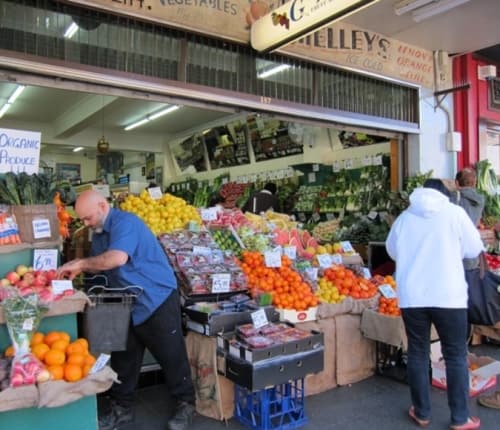Fruit and Vegetable Shops v the Supermarkets
Food security is a major environmental issue on a global scale. Food waste is a big part of that problem with waste occurring at all stages of production, distribution and consumption. In Australia, a unique factor arises from the dominant position of the two supermarkets, Coles and Woolworths. While the supermarkets are not currently as dominant in fruit and vegetable sales as in general groceries, with about 45.5% of the market in 2012, their effects are still substantial.
The Bulletin interviewed well-known local fruit and vegetable supplier, Joe Galluzzo, on his experience of the effects of the supermarket chains on the trade. Joe can draw on his nine years of experience as a growers’ agent, for banana suppliers, as well as his retail experience. So he has seen both sides of the trade – the growers and the retailers.
Joe has particularly noticed the effect of the supermarket on the central market, which has shrunk in scale and effectiveness in recent years. This is largely because the supermarkets have bypassed the market by buying direct from large growers. As the central market has declined in scale the support services it offers have also declined. For example, the Department of Agriculture no longer provides a service of grading the fruit and vegetables available, with competing independent valuers taking their place. The result is a profusion of terms and lack of clarity about standards of quality. This places the onus onto the independent retailers to have the experience to make these judgements themselves.
Supermarkets also have the capacity to distort the market price, especially in seasonal produce such as avocados. They can afford to pay a top price and sell at a loss in order to essentially capture the market, leaving the independents with either lower quality fruit or the need to charge a higher price.
Joe feels that the long-term trend is very clear as more and more of the independent fruit and vegetable retailers close and are not replaced. He comments that Sydney has traditionally had a large independent sector compared to Melbourne, but that it is now shrinking, with increasing areas of Sydney having no access to independent fruit and vegetable outlets.
This has a corresponding effect on small producers, who don’t have the option of selling to the large supermarkets and depend on independent buyers. Over time the trend is towards fewer small growers as well as fewer small retailers. And it is the small growers that provide us with the variety and range of produce.

Malcolm Knox, in his recent book Supermarket Monsters, documents the effects of the dominance of large growers locked into contracts with the major supermarkets. To meet contract requirements they must have the maximum possible quantity available in case it is required, although usually it is not and the excess is wasted. At the same time, the diversity of fruit and vegetables has been lost. For example, he notes that French beans are the only variety supplied. Indeed, we might say that many people are unaware of any other type of bean. So the twofold effect is production on a factory like scale with large-scale wastage accepted as normal, while small-scale growers and the diversity of produce they bring gradually disappear.
In the face of this trend, it is clear that we are in a privileged position in Glebe, with a number of local independent fruit and vegetable outlets to choose from. While the lure of ‘one stop shopping’ for the time-poor consumer is understandable, in the long term handing it to the big supermarkets to supply all our food will make us poorer in much more significant ways.










There are no comments yet. Please leave yours.